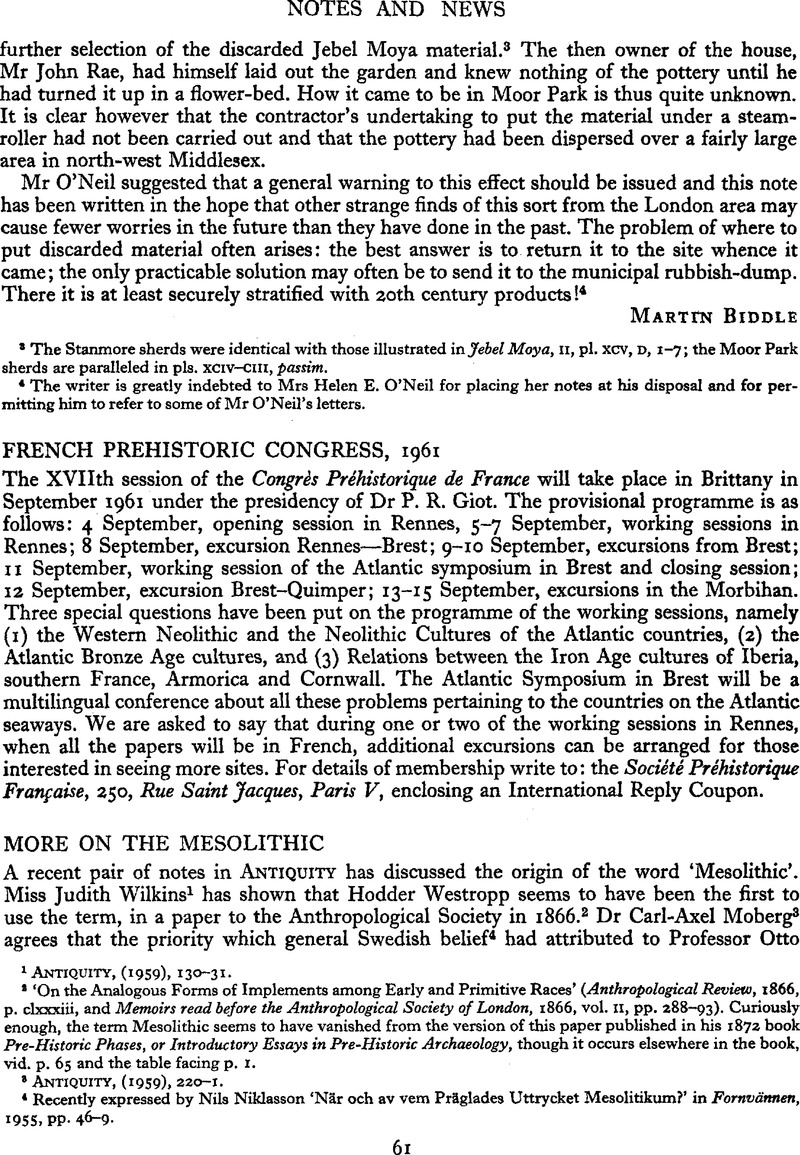Article contents
More on the Mesolithic
Published online by Cambridge University Press: 02 January 2015
Abstract

- Type
- Notes and News
- Information
- Copyright
- Copyright © Antiquity Publications Ltd 1961
References
1 ANTIQUITY, (1959), 130–31.
2 ‘On the Analogous Forms of Implements among Early and Primitive Races’ (Anthropological Review, 1866, p. CLXXXIII, and Memoirs read before the Anthropological Society of London, 1866, vol. II, pp. 288–93). Curiously enough, the term Mesolithic seems to have vanished from the version of this paper published in his 1872 book Pre-Historic Phases, or Introductory Essays in Pre-Historic Archaeology, though it occurs elsewhere in the book, vid. p. 65 and the table facing p. 1.
3 ANTIQUITY, (1959), 220–1.
4 Recently expressed by Nils Niklasson ‘När och av vem Präglades Uttrycket Mesolitikum?’ in Fornvännen, 1955. pp. 46–9.
5 ‘Démonstration de l’Emmanchure des Instruments des trois Epoques de l’Age de la Pierre’ (Mémoires de la Société d’Ethnographie, Paris, vol. 12, part 2, 1874, pp. 225-31); ‘Chronologie de la Pierre’ (Bull. Soc. d’Anth. de Paris, vol. VII, 1873, pp. 523–31).
6 ‘L’Homme préhistorique dans le Bassin de la Plata’ (Congrès International des Sciences Anthropologiques, Paris, 1878) (1880), pp. 341–50.
7 ‘On the Continuity of the Palaeolithic and Neolithic Periods’, JAI, XXII, no. 1–2, 1892, pp. 66–98.
8 ‘On some highly specialized Forms of Stone Implements found in Asia, North Africa and Europe’, JAI, XVIII, 1888–9, pp. 134–9.
9 G. de G. Sieveking has recently published some further biographical details on A. C. Carlyle, and it seems that in the Catalogue of the Exhibition of Paintings, Sculpture, Indian Antiquities, etc., published in 1887, certain of the flint collections were described in Section V as Palaeolithic and Mesolithic. (‘Morhana Pahar: or the Mystery of A. C. Carlyle’, MAN, vol. LX, 140, July 1960, pp. 98–100.)
10 ‘Anthropology in England early in the present Century’, American Anthropologist, vol. 59, no. 5, 1957, p. 788.
11 Westropp, op. cit., 1872, p. 115.
- 1
- Cited by


